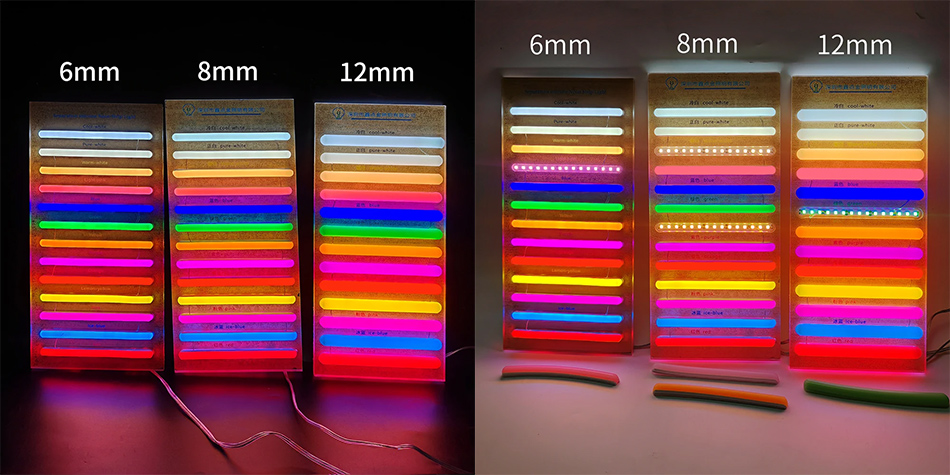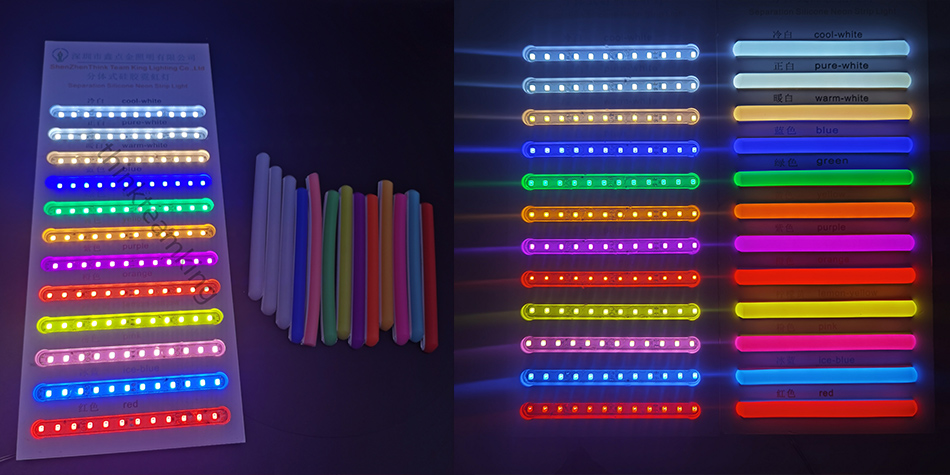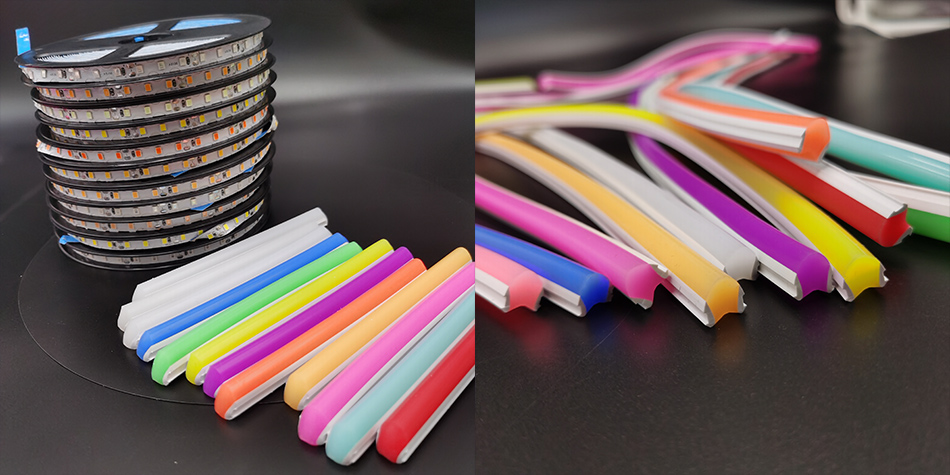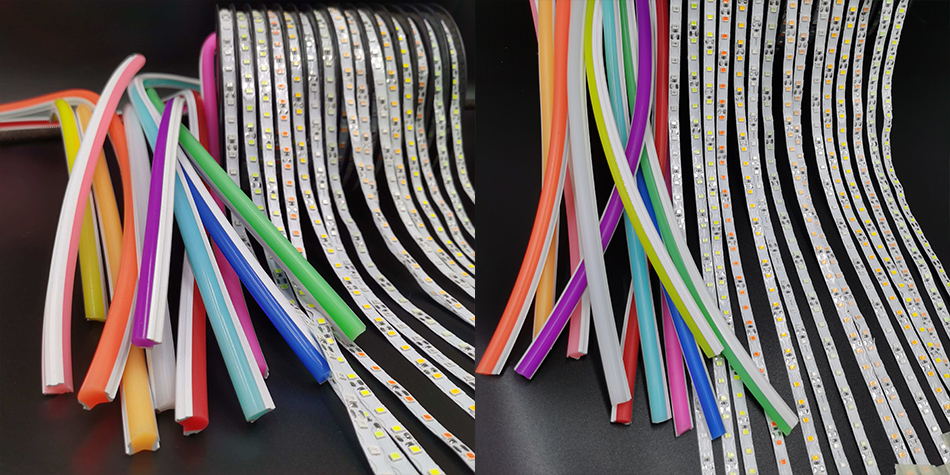Time:2025-06-27
In the ever - evolving world of lighting technology, dimmable silicone neon LED strip controllers have emerged as a game - changing component. These controllers are designed to work in tandem with silicone - encapsulated neon LED strips, offering users an unprecedented level of control over their lighting setups. Whether for creating a cozy ambiance at home, enhancing the visual appeal of a commercial space, or adding a touch of creativity to an event, these controllers play a pivotal role. This article explores the intricacies of dimmable silicone neon LED strip controllers, from their underlying technology to their diverse applications and future trends.
Understanding the Technology Behind Dimmable Silicone Neon LED Strip Controllers
LED Driver Chips and Their Function
At the heart of any dimmable silicone neon LED strip controller is the LED driver chip. This chip is responsible for converting the incoming electrical power into a suitable form to drive the LEDs in the strip. The driver chip takes the input voltage, which could be from a standard household power supply or a dedicated low - voltage power adapter, and adjusts it to the appropriate voltage and current levels required by the LEDs.
For instance, if the silicone neon LED strip operates on a low - voltage DC (Direct Current) power source, the driver chip will convert the incoming AC (Alternating Current) power from the wall outlet into the correct DC voltage. It also ensures that the current flowing through the LEDs is regulated precisely. This is crucial because LEDs are sensitive to current; too much current can overheat and damage the LEDs, while too little can result in dim or inconsistent lighting. The driver chip continuously monitors and adjusts the current to maintain a stable and optimal lighting output.
Dimming Mechanisms
Dimmable silicone neon LED strip controllers employ various dimming mechanisms to adjust the brightness of the LEDs. One common method is Pulse - Width Modulation (PWM). In PWM dimming, the controller rapidly switches the power to the LEDs on and off at a high frequency. By varying the ratio of the on - time to the off - time (the duty cycle), the average power delivered to the LEDs is changed, thereby controlling their brightness. For example, if the duty cycle is 50%, the LEDs are on for half of the time and off for the other half, resulting in a certain brightness level. Increasing the duty cycle to 80% will make the LEDs appear brighter as they are on for a longer proportion of the time.
Another dimming technique is Analog Dimming. This involves changing the voltage supplied to the LEDs. As the voltage decreases, the brightness of the LEDs also decreases proportionally. However, compared to PWM dimming, Analog Dimming may sometimes cause color shifting in some types of LEDs, which is why PWM is more widely used for dimmable silicone neon LED strip controllers, especially when color consistency is crucial.
Communication and Control Interfaces
These controllers are equipped with different communication and control interfaces to enable users to interact with them. Some controllers come with a simple wired remote control. The remote has buttons that allow users to adjust the brightness, switch between different lighting modes (such as static, flashing, or fading), and in the case of RGB - capable controllers, change the color of the silicone neon LED strips.
In more advanced setups, wireless communication protocols are used. Bluetooth - enabled controllers are popular for home and small - scale commercial applications. Users can download a dedicated mobile app on their smartphones or tablets and connect to the controller via Bluetooth. This provides a more convenient and user - friendly way to control the lighting, with additional features like creating custom lighting scenes, scheduling the lights to turn on or off at specific times, and adjusting the lighting remotely from within the Bluetooth range.
For larger commercial installations or smart home systems, Wi - Fi or ZigBee - based controllers may be used. These offer the advantage of wider range and integration with other smart home devices. For example, a Wi - Fi - enabled dimmable silicone neon LED strip controller can be integrated into a home automation system, allowing it to be controlled along with other lighting fixtures, thermostats, and security systems, all through a central control hub or a voice - controlled assistant like Amazon Alexa or Google Assistant.

Key Features of Dimmable Silicone Neon LED Strip Controllers
Precise Brightness Control
One of the primary features of these controllers is their ability to provide precise brightness control. Whether it's a gentle, subtle dimming for a relaxing atmosphere in a bedroom or a more significant reduction in brightness for a movie - watching setup, users can adjust the brightness level to their exact preference. The dimming range is typically wide, allowing for a seamless transition from full - brightness to near - complete darkness. This level of control is not only useful for creating the right mood but also for energy conservation. By reducing the brightness when full illumination is not required, users can lower their energy consumption without sacrificing the functionality or aesthetic appeal of the lighting.
Color Control (for RGB - Capable Controllers)
Many dimmable silicone neon LED strip controllers support RGB (Red, Green, Blue) lighting. These controllers can mix different proportions of red, green, and blue light to create a vast spectrum of colors. Users can choose from pre - set color palettes on the controller or its associated app, or they can even create their custom colors. This feature is highly versatile and is often used in applications such as event lighting, where the color of the lights can be changed to match the theme or mood of the event. In retail stores, RGB - capable dimmable controllers can be used to highlight products in different colors, attracting customers' attention and enhancing the visual display.
Multiple Lighting Modes
These controllers offer a variety of lighting modes to add dynamism to the lighting setup. Static mode keeps the LEDs at a constant brightness and color, which is suitable for areas where a stable, consistent light is required, such as in a workspace or a hallway. Flashing mode, on the other hand, makes the LEDs turn on and off at a set frequency, creating a strobe - like effect. This can be used in entertainment venues or for creating a sense of urgency in certain commercial applications. Fading mode gradually changes the brightness or color of the LEDs over time, creating a smooth and elegant transition. This mode is often used in decorative lighting, such as in a hotel lobby or a high - end restaurant, to add a touch of sophistication.
Compatibility with Silicone Neon LED Strips
Dimmable silicone neon LED strip controllers are specifically designed to be compatible with silicone - encapsulated LED strips. The silicone casing of the strips offers several advantages, such as flexibility, durability, and protection against moisture and dust. The controller is engineered to work seamlessly with these strips, taking into account their electrical characteristics and the unique requirements of the silicone - based construction. This compatibility ensures that the controller can effectively drive the LEDs in the strip, providing reliable and efficient operation, regardless of whether the strip is installed indoors or outdoors in a variety of environmental conditions.

Applications of Dimmable Silicone Neon LED Strip Controllers
Residential Lighting
In homes, dimmable silicone neon LED strip controllers find numerous applications. Under - cabinet lighting in the kitchen can be controlled with these controllers. Homeowners can dim the lights when they want a soft, ambient glow while cooking or entertaining guests, and brighten them up when they need more light for food preparation. In the living room, the controllers can be used to adjust the brightness and color of LED strips installed behind the TV or along the edges of the ceiling. This can create a more immersive viewing experience or set a relaxing mood for reading or socializing. In bedrooms, dimmable controllers allow users to create a cozy and calming environment by adjusting the brightness and color of the LED strips, which can be installed under the bed or around the headboard.
Commercial and Retail Spaces
Commercial and retail establishments also benefit greatly from dimmable silicone neon LED strip controllers. In retail stores, these controllers can be used to highlight products on shelves or in display cases. By adjusting the brightness and color of the LED strips, store owners can draw customers' attention to specific items, making them more appealing and increasing the likelihood of a sale. In restaurants and cafes, the controllers can be used to create different lighting scenes for different times of the day or for special events. For example, during the day, the lights can be set to a bright, inviting level, while in the evening, they can be dimmed and the color can be adjusted to create a more intimate and romantic atmosphere. In offices, dimmable LED strip controllers can be used to provide task lighting that can be adjusted according to the needs of the employees, improving productivity and comfort.
Event and Entertainment Venues
Event and entertainment venues rely heavily on dimmable silicone neon LED strip controllers to create captivating lighting effects. In nightclubs and music venues, these controllers can be used to synchronize the LED strip lighting with the music, creating a dynamic and energetic atmosphere. The ability to change the brightness, color, and lighting modes in real - time allows for a more engaging experience for the patrons. At weddings and parties, dimmable controllers can be used to create a customized lighting scheme that matches the theme and mood of the event. For example, the LED strips can be set to a soft, warm color for the ceremony and then changed to a more vibrant, colorful setting for the reception and dancing.
Automotive Lighting
In the automotive industry, dimmable silicone neon LED strip controllers are used to enhance the interior and exterior lighting of vehicles. Inside the car, LED strips installed under the seats, along the dashboard, or in the footwells can be controlled with these controllers. Drivers and passengers can adjust the brightness and color of the lights to their preference, creating a more comfortable and personalized driving or riding experience. On the exterior, LED strips used for accentuating the vehicle's body lines or for additional lighting around the wheels can also be controlled with dimmable controllers. This not only adds a unique aesthetic touch to the vehicle but can also improve visibility and safety in low - light conditions.

Installation and Setup of Dimmable Silicone Neon LED Strip Controllers
Power Connection
The first step in installing a dimmable silicone neon LED strip controller is to connect it to a power source. The power requirements of the controller and the LED strip it will be driving must be carefully considered. For low - voltage LED strips, a suitable power adapter is needed to convert the standard household voltage to the appropriate low - voltage DC power. The power adapter should be rated to handle the total power consumption of the LED strip. When connecting the power, it's crucial to follow the manufacturer's instructions precisely to avoid any electrical hazards. The positive and negative terminals of the power source must be correctly connected to the corresponding terminals on the controller.
Connecting the LED Strips
Once the power connection is established, the silicone neon LED strips need to be connected to the controller. The strips usually have connectors at their ends that can be easily attached to the output terminals on the controller. Make sure that the strips are properly aligned and securely connected to ensure a stable electrical connection. In some cases, if multiple LED strips are being used, they may need to be daisy - chained together before connecting to the controller. This involves connecting the output of one strip to the input of the next strip in a sequential manner. It's important to note that the total length and power consumption of all the connected LED strips should not exceed the maximum capacity of the controller.
Controller Configuration
After the physical connections are made, the next step is to configure the controller. If it's a simple wired remote - controlled controller, the basic functions such as brightness adjustment and mode selection can usually be accessed directly from the remote. For wireless - enabled controllers, such as those with Bluetooth or Wi - Fi connectivity, the first step is to pair the controller with the controlling device, such as a smartphone or a smart home hub. This typically involves downloading the appropriate app (in the case of Bluetooth or Wi - Fi controllers) and following the on - screen instructions to establish the connection. Once connected, users can explore the various features of the controller, such as creating custom lighting scenes, adjusting the color palette, and setting schedules for the lights.

Maintenance and Troubleshooting of Dimmable Silicone Neon LED Strip Controllers
Regular Checks
To ensure the optimal performance of dimmable silicone neon LED strip controllers, regular checks are essential. Periodically inspect the physical connections between the controller, the power source, and the LED strips. Look for any signs of loose connections, frayed wires, or damaged connectors. If any issues are detected, they should be addressed immediately to prevent further problems, such as flickering lights or complete failure of the lighting system.
Also, keep an eye on the performance of the controller itself. If you notice any abnormal behavior, such as inconsistent dimming, incorrect color changes, or unresponsive controls, it could be an indication of a problem with the controller. In some cases, these issues may be resolved by simply resetting the controller to its factory settings and re - configuring it.
Troubleshooting Common Issues
If the LED strips are not lighting up at all, the first thing to check is the power supply. Make sure that the power adapter is plugged in correctly and that it is providing the correct voltage. Check the fuses or circuit breakers in the power supply circuit as well. If the power supply is functioning properly, then check the connections between the controller and the LED strips. A loose or damaged connection could prevent the current from flowing to the strips.
For dimming - related issues, such as the LEDs not dimming smoothly or not dimming at all, it could be due to a problem with the dimming mechanism in the controller. If it's a PWM - based controller, issues with the PWM signal generation or transmission could be the cause. In such cases, it may be necessary to replace the controller if the problem cannot be resolved through software - based resets or adjustments. For RGB - capable controllers with color - related problems, such as incorrect color output or color shifting, the issue could be with the color - mixing algorithms in the controller or a problem with the LEDs themselves. Testing the LEDs with a known - good controller or vice versa can help identify the source of the problem.

Trends and Future Developments in Dimmable Silicone Neon LED Strip Controllers
Integration with Smart Home Ecosystems
One of the major trends in dimmable silicone neon LED strip controllers is their increasing integration with smart home ecosystems. As more and more households are adopting smart home technologies, the ability to control lighting as part of a unified smart home system is becoming a key selling point. Future controllers are likely to be more seamlessly integrated with popular smart home platforms, allowing for greater interoperability with other smart devices such as thermostats, security cameras, and voice - controlled assistants. This integration will enable users to create more complex and automated lighting scenes. For example, the lights could be set to automatically adjust their brightness and color based on the time of day, the occupancy of a room, or even the weather outside.
Energy - Efficiency Improvements
With the growing focus on energy conservation, future dimmable silicone neon LED strip controllers are expected to see significant improvements in energy efficiency. Manufacturers are likely to develop more advanced driver chips and control algorithms that can further reduce the power consumption of the controller and the LED strips while maintaining or even enhancing their performance. This could involve the use of more efficient power - conversion techniques, better - optimized dimming algorithms, and the integration of energy - monitoring and management features. For example, controllers may be able to automatically adjust the lighting based on the energy consumption of other devices in the home, ensuring that the overall energy usage remains within a set limit.
Enhanced User Interfaces
The user interface of dimmable silicone neon LED strip controllers is also set to evolve. Future controllers are likely to offer more intuitive and user - friendly interfaces, whether it's through mobile apps or physical controls. Mobile apps may feature more advanced features such as augmented reality (AR) previews of lighting scenes. Users could use their smartphones to point at a room and see a virtual representation of how different lighting settings would look in that space before actually applying them. Physical controllers may also be redesigned to be more ergonomic and easier to use, with tactile feedback and better - organized controls for quick access to frequently used functions.
In conclusion, dimmable silicone neon LED strip controllers have revolutionized the way we control and experience lighting. With their advanced technology, diverse features, and wide range of applications, they have become an essential component in modern lighting setups. As technology continues to advance, these controllers are poised to offer even more functionality, energy efficiency, and integration capabilities, further enhancing the lighting experience in various settings.As consumers become more environmentally conscious and tech - savvy, the demand for dimmable silicone neon LED strip controllers will only continue to grow. This will drive further innovation in the field, leading to the development of controllers that are not only more intelligent and energy - efficient but also easier to install and use. Manufacturers and researchers will likely focus on addressing current limitations, such as improving the lifespan of controllers and enhancing their compatibility with emerging LED technologies. This continuous innovation will ensure that dimmable silicone neon LED strip controllers remain at the forefront of the lighting industry, meeting the evolving needs of users across different sectors. Moreover, as the Internet of Things (IoT) continues to expand, dimmable silicone neon LED strip controllers may also be integrated with industrial IoT systems. This would enable large - scale, centralized control of lighting in commercial buildings, factories, and public spaces, optimizing energy usage and management efficiency. In addition, the development of artificial intelligence (AI) may also bring new possibilities to dimmable silicone neon LED strip controllers. AI algorithms could analyze user behavior patterns and preferences over time, automatically adjusting the lighting to suit different moods and activities without manual intervention. For example, the system might learn that a user typically prefers warm, dim lighting in the evenings for relaxation and proactively sets the LEDs accordingly. This level of intelligent automation would take the convenience and personalization of lighting control to a whole new level.